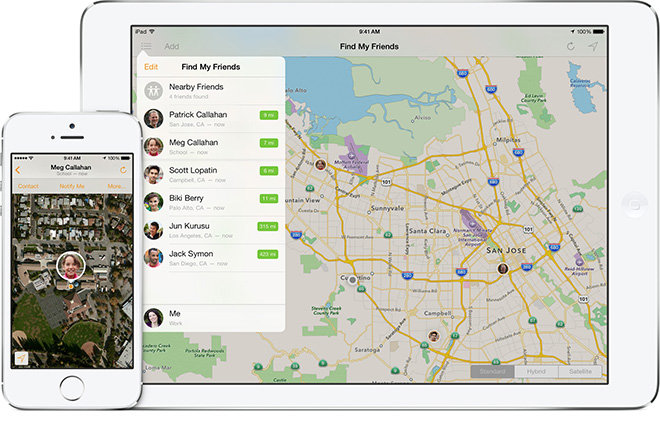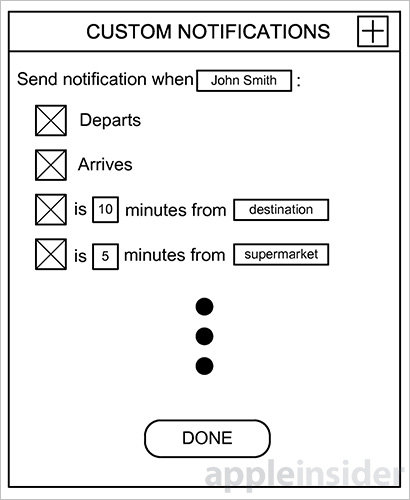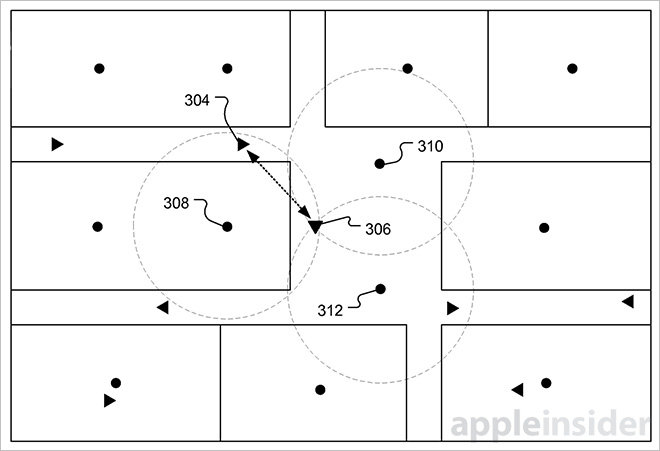A pair of Apple patent applications published Thursday point to ongoing research in mobile device location sharing, one being an augmentation of existing iOS geofencing technology, and another detailing an entirely new form of indoor request-and-answer location notifications reliant on node-based triangulation.
Apple has for some time exhibited an intense interest in geofencing technology, or adjustable virtual boundaries based on real world location data that can trigger any number of operations, from turning on smart home appliances to alerting other users of your estimated arrival time. In iOS, geofencing is leveraged by apps like Find My iPhone, but perhaps more interesting is research into tangential technology that helps two consenting mobile device users swap location information automatically.
Apple's filing for "Customized location notification" describes a useful tweak to an existing iOS feature that allows users to send and receive custom event-based notifications from friends as they move through preset zones. Currently, Apple's Find My Friends app in iOS 8 allows users to send current location, or request alerts when a friend passes over a geofence boundary, but lacks tools to integrate automatic text generation or multi-point tracking.
As described, a first user requests that a second user share their location and agree to send and receive notification pushes via text, email string or other form of communication. When accepted, the first device sends over custom notification event data to the second device, including a description of the event and the ability to obtain or automatically generate custom notifications.
From there, the second device may create a route to said event, which can be shared if route sharing is activated, and begin to broadcast custom notifications when it leaves or enters a predetermined geofenced zone.
Applied to the real world, User A sends a custom notification event request to User B that includes one or more geofenced points of interest with corresponding messages. In the example above, User A specified that a message be sent or generated to User B when they are within five minutes of a supermarket.
When said geofence is crossed, as determined by an onboard mapping application, a message is sent to User A, saying, "User B is 5 minutes from a supermarket." A response message might then be generated, in this case asking User B to detour to the market. If accepted, a POI marker and route correction are displayed on User B's device.
Apple's second patent application, titled "Indoor remote triggered location scanning" focuses on positioning within structures using wireless transceivers referred to as "nodes."
The entire system relies on static nodes deployed at known locations throughout a building, with devices like smartphones acting as secondary mobile nodes for fine accuracy refinements. Permanent nodes may be capable of peer-to-peer communication, while mobile nodes might rely on Wi-Fi or other robust networking protocols. Importantly, each device in the system is interconnected in some way, either directly or through proxies interfaced with larger network.
In practice, an originating device requests the location of a second device through a Contacts entry, dedicated location sharing user interface or any other suitable means. Upon acceptance of the location scan request, a second device performs a trilateration operation. In one embodiment, the device receives wireless signals from at least three nearby permanent nodes and analyzes their strength to determine distance between itself and said nodes. This information is used to create overlapping circles or spheres that can be used to pinpoint a device's location within a building.
From there, location data can be transmitted to the originating device through the node network or, if applicable, a direct peer-to-peer connection.
One interesting implementation stores unique device identifier tokens at sequential nodes as a tracked device moves through the building like a digital breadcrumb trail. This data is sent wirelessly to another device through the network, or accessed peer-to-peer from a permanent node.
The document also discusses device authorization, alternative triangulation techniques involving mobile nodes, inter-device communication techniques and map pathing.
As with any Apple patent, it remains unclear if the company plans to incorporate its location sharing technology in a future iOS version. Apple has sunk a substantial amount of resources into its in-house mapping initiative, of which location sharing is a part, including the $20 million purchase of indoor mapping startup WiFiSLAM in 2013.
Most recently, the company confirmed that sensor-laden vans spotted roaming around the U.S. and Europe are part of an effort to improve Apple Maps. It has been speculated that data from the project will end up in a product rivaling Google's Street View.
Apple's location sharing patent applications were both filed for in December 2013 and name Devrim Varoglu and Swapnil R. Dave as their inventors. Michael Kim is also credited in the second filing.
 Mikey Campbell
Mikey Campbell








-xl-m.jpg)


-m.jpg)






 Amber Neely
Amber Neely
 William Gallagher
William Gallagher
 Malcolm Owen
Malcolm Owen

 Mike Wuerthele
Mike Wuerthele


 Thomas Sibilly
Thomas Sibilly








8 Comments
This kind of indoor geolocation seems to depend on a system like iBeacon to already be in place. Do retailers have obvious incentives to implement iBeacons like they do with Apple Pay?
This kind of indoor geolocation seems to depend on a system like iBeacon to already be in place.
Do retailers have obvious incentives to implement iBeacons like they do with Apple Pay?
I see them fairly often, so there must be some appeal.
This'd be nice if it would just activate Wi-Fi automatically in locations you set, which should be possible.
Google's Android R&D team get new instructions ....
Do retailers have obvious incentives to implement iBeacons like they do with Apple Pay?
If a retailer has an app installed on a significant number of their shoppers devices, iBeacons are pretty compelling from the retailers perspective. The app can register for notifications from specific beacon ID's and those beacons can wake the app up when the device is in a certain range (immediate area, close, roughly nearby, etc.). In iOS, there aren't many ways that an app can be awoken from an external stimulus... push notifications would be another, but it's not as useful for the purpose of tracking/monitoring people.
The app can report back to the retailer where the user is relative to a store, stand, product, etc. or where they spend how much time within a store. They can also notify the user telling them about sales or otherwise luring them into the store/towards a particular product. It's somewhat creepy but potentially useful from the customer's perspective and incredibly valuable from the retailers perspective.
I've tried geofencing a couple times. Never worked very well for me. I found it to be unreliable, imprecise and delayed by a few minutes. It might work for something like: remember to buy flowers for my wife when I leave the office, but I tried to set it to remind me to get my reusable shopping bags out of the trunk of the car when I arrive at the grocery store - it reminded me about five minutes later when I was already in the store. Other times it never reminded me at all.